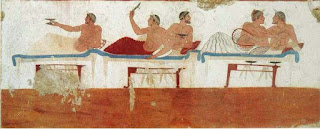Symposium. Image from http://farm3.static.flickr.com/
The warrior feast was central to the Homeric image of society; under the influence of the near east in the period 750–650 bc more complex rituals of pleasure arose. The time of ‘drinking together’ (symposion) was separated from the preceding meal (deipnon) and became the focus of attention. The male participants wore garlands, and libations and prayers began and ended the proceedings. The Greeks adopted the practice of reclining on the left elbow (one or two to a couch); from this evolved a characteristic shape of room, and a standard size for the drinking group of between fourteen and 30: the andrōn or men's room was square, arranged with a door off centre to fit usually seven or fifteen couches; larger sizes tended to destroy the unity of sympotic space. Many such rooms have been recognized archaeologically, but the best representation is the painted Tomb of the Diver at Paestum (60km./37 mi. SE of Neapolis). They were supplied with low tables, cushions, decorated couches, and wall hangings. By the late 6th cent. a repertoire of vessels had been elaborated, including different cup shapes, jugs, wine coolers, and wine mixing bowls (Gk. krātēr): the decoration of these vases offers a set of self conscious images related to the activities of the drinking group Water was mixed with the wine in a central krater to a strength determined by the president (usually three or four to one, or about the strength of modern beer); it was served by slave boys. Equality and order in distribution were maintained: each krātēr measured a stage in the progress towards drunkenness. At the end of the session a merry procession (kōmos) in the streets would demonstrate the cohesion and power of the group.
(From http://www.jrank.org/history/)
(From http://www.jrank.org/history/)
Kottabos. Image from http://www.mlahanas.de/Greeks/Arts/Painting/Tomb4.jpg
Social wine drinking in Greece led to the invention of a curious game, Kottabos, which remained highly popular for at least three centuries. The game, combining grace with skill, consisted of striking a collapsible target with the small amount of wine remaining in a cup after the draught is drunk. The target, resting atop a rod, was usually a metallic saucer. If the aim was good, the target tipped over, to clatter noisily onto the floor or to strike another metallic object below.
It seems the game was invented by Greeks in Sicily, as a fitting entertainment after a meal. For one thing, it required no great physical effort that would disturb the digestion. For another, it allowed the company to admire the graceful motions of young people of both sexes, their heads covered with wreaths of flowers, taking careful aim and twirling their cup with a flick of the wrist to send a few drops of wine toward the target –called a plastinx. The game grew to be so popular that those who could afford it had their houses equipped with special kottabos rooms, circular in shape so that the couches of all the participants, lined up against the wall, were at the same distance from the central pole and the plastinx. Professionals gave instructions in the game, in which the grace of stance and motion were counted together with the accuracy of the aim. Special kottabos cups were made, their shape designed to favor the accurate delivery of the liquid.
References.
Alexander Dorzvnski, Bibiane Bell. The Wine Book. Wines and Wine Making Around the World. New York. 1969


No comments:
Post a Comment